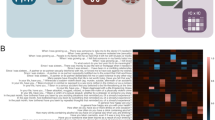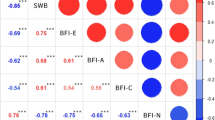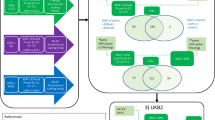Abstract
Subjective well-being (SWB) has been explored in European ancestral populations; however, whether the SWB genetic architecture is shared across populations remains unclear. We conducted a cross-population genome-wide association study for SWB using samples from Korean (n = 110,919) and European (n = 563,176) ancestries. Five ancestry-specific loci and twelve cross-ancestry significant genomic loci were identified. One novel locus (rs12298541 near HMGA2) associated with SWB was also identified through the European meta-analysis. Significant cross-ancestry genetic correlation for SWB between samples was observed. Polygenic risk analysis in an independent Korean cohort (n = 22,455) demonstrated transferability between populations. Significant correlations between SWB and major depressive disorder, and significant enrichment of central nervous system-related polymorphisms heritability in both ancestry populations were found. Hence, large-scale cross-ancestry genome-wide association studies can advance our understanding of SWB genetic architecture and mental health.
This is a preview of subscription content, access via your institution
Access options
Access Nature and 54 other Nature Portfolio journals
Get Nature+, our best-value online-access subscription
$29.99 / 30 days
cancel any time
Subscribe to this journal
Receive 12 digital issues and online access to articles
$119.00 per year
only $9.92 per issue
Buy this article
- Purchase on Springer Link
- Instant access to full article PDF
Prices may be subject to local taxes which are calculated during checkout





Similar content being viewed by others
Data availability
Data from the UKB and 23andMe are available on application to each site (UKB, https://www.ukbiobank.ac.uk; 23andMe, https://research.23andme.com/dataset-access/). Summary statistics of Okbay and colleagues7 are publicly available at the Social Science Genetic Association Consortium (SSGAC, https://www.thessgac.org/). The full summary statistics of the KBA GWAS are available at the NHGRI-EBI GWAS Catalog (https://www.ebi.ac.uk/gwas/downloads).
Code availability
Previously developed pipelines were used to produce the results for the current study. No custom code was developed. Please see the Supplementary Information for details on the software URLs and data used.
References
Diener, E. Subjective well-being. The science of happiness and a proposal for a national index. Am. Psychol. 55, 34–43 (2000).
Steptoe, A., Deaton, A. & Stone, A. A. Psychological wellbeing, health and ageing. Lancet 385, 640–648 (2015).
Malone, C. & Wachholtz, A. The relationship of anxiety and depression to subjective well-being in a mainland chinese sample. J. Relig. Health 57, 266–278 (2018).
Machado, L., de Oliveira, I. R., Peregrino, A. & Cantilino, A. Common mental disorders and subjective well-being: emotional training among medical students based on positive psychology. PLoS ONE 14, e0211926 (2019).
Haworth, C. M., Carter, K., Eley, T. C. & Plomin, R. Understanding the genetic and environmental specificity and overlap between well-being and internalizing symptoms in adolescence. Dev Sci 20, e12376 (2017).
Nes, R. B. & Røysamb, E. in Genetics of Psychological Well-Being: The Role of Heritability and Genetics in Positive Psychology (ed M. Pluess) 75–96 (Oxford Univ. Press, 2015).
Okbay, A. et al. Genetic variants associated with subjective well-being, depressive symptoms, and neuroticism identified through genome-wide analyses. Nat. Genet. 48, 624–633 (2016).
Turley, P. et al. Multi-trait analysis of genome-wide association summary statistics using MTAG. Nat. Genet. 50, 229–237 (2018).
Baselmans, B. M. L. et al. Multivariate genome-wide analyses of the well-being spectrum. Nat. Genet. 51, 445–451 (2019).
Moon, S. et al. The korea biobank array: design and identification of coding variants associated with blood biochemical traits. Sci. Rep. 9, 1382 (2019).
Spracklen, C. N. et al. Identification of type 2 diabetes loci in 433,540 East Asian individuals. Nature 582, 240–245 (2020).
Kim, Y., Han, B. G. & Ko, G. E. S. G. Cohort profile: The Korean Genome and Epidemiology Study (KoGES) consortium. Int J. Epidemiol. 46, e20 (2017).
Bycroft, C. et al. The UK Biobank resource with deep phenotyping and genomic data. Nature 562, 203–209 (2018).
Brown, B. C. et al. Transethnic genetic–correlation estimates from summary statistics. Am. J. Hum. Genet 99, 76–88 (2016).
Bulik-Sullivan, B. K. et al. LD score regression distinguishes confounding from polygenicity in genome-wide association studies. Nat. Genet. 47, 291–295 (2015).
Ward, L. D. & Kellis, M. HaploReg: a resource for exploring chromatin states, conservation, and regulatory motif alterations within sets of genetically linked variants. Nucl. Acids Res. 40, D930–D934 (2012).
Li, X. et al. Common variants on 6q16.2, 12q24.31 and 16p13.3 are associated with major depressive disorder. Neuropsychopharmacology 43, 2146–2153 (2018).
Ward, J. et al. The genomic basis of mood instability: identification of 46 loci in 363,705 UK Biobank participants, genetic correlation with psychiatric disorders, and association with gene expression and function. Mol. Psychiatry 25, 3091–3099 (2020).
Converge Consortium. Sparse whole-genome sequencing identifies two loci for major depressive disorder. Nature 523, 588–591 (2015).
Kanai, M. et al. Genetic analysis of quantitative traits in the Japanese population links cell types to complex human diseases. Nat. Genet. 50, 390–400 (2018).
Zhao, B. et al. Genome-wide association analysis of 19,629 individuals identifies variants influencing regional brain volumes and refines their genetic co-architecture with cognitive and mental health traits. Nat. Genet. 51, 1637–1644 (2019).
Finucane, H. K. et al. Partitioning heritability by functional annotation using genome-wide association summary statistics. Nat. Genet. 47, 1228–1235 (2015).
Lindblad-Toh, K. et al. A high-resolution map of human evolutionary constraint using 29 mammals. Nature 478, 476–482 (2011).
Brainstorm, C. et al. Analysis of shared heritability in common disorders of the brain. Science 360, eaap8757 (2018).
Liu, J. Z. et al. Association analyses identify 38 susceptibility loci for inflammatory bowel disease and highlight shared genetic risk across populations. Nat. Genet. 47, 979–986 (2015).
Hsu, S. D. H. et al. Accurate genomic prediction of human height. Genetics 214, 231–497 (2020).
Okada, Y., Eyre, S., Suzuki, A., Kochi, Y. & Yamamoto, K. Genetics of rheumatoid arthritis: 2018 status. Ann. Rheum. Dis. 78, 446–453 (2019).
Martin, A. R. et al. Clinical use of current polygenic risk scores may exacerbate health disparities. Nat. Genet. 51, 584–591 (2019).
Koyama, S. et al. Population-specific and trans-ancestry genome-wide analyses identify distinct and shared genetic risk loci for coronary artery disease. Nat. Genet. 52, 1169–1177 (2020).
Giri, A. et al. Trans-ethnic association study of blood pressure determinants in over 750,000 individuals. Nat. Genet. 51, 51–62 (2019).
Lam, M. et al. Comparative genetic architectures of schizophrenia in East Asian and European populations. Nat. Genet. 51, 1670–1678 (2019).
Klarin, D. et al. Genetics of blood lipids among ~300,000 multi-ethnic participants of the Million Veteran Program. Nat. Genet. 50, 1514–1523 (2018).
Nagel, M. et al. Meta-analysis of genome-wide association studies for neuroticism in 449,484 individuals identifies novel genetic loci and pathways. Nat. Genet. 50, 920–927 (2018).
Wray, N. R. et al. Genome-wide association analyses identify 44 risk variants and refine the genetic architecture of major depression. Nat. Genet. 50, 668–681 (2018).
Mullins, N. et al. Genome-wide association study of more than 40,000 bipolar disorder cases provides new insights into the underlying biology. Nat. Genet. 53, 817–829 (2021).
Pearson, C. A. et al. Foxp1 regulates neural stem cell self-renewal and bias toward deep layer cortical fates. Cell Rep. 30, 1964–1981 e1963 (2020).
White, C. C. et al. Identification of genes associated with dissociation of cognitive performance and neuropathological burden: multistep analysis of genetic, epigenetic, and transcriptional data. PLoS Med. 14, e1002287 (2017).
Maruani, A. et al. 11q24.2-25 Micro-rearrangements in autism spectrum disorders: relation to brain structures. Am. J. Med. Genet. A 167A, 3019–3030 (2015).
Xi, Y. et al. HMGA2 promotes adipogenesis by activating C/EBPβ-mediated expression of PPARgamma. Biochem. Biophys. Res. Commun. 472, 617–623 (2016).
Nishino, J., Kim, I., Chada, K. & Morrison, S. J. Hmga2 promotes neural stem cell self-renewal in young but not old mice by reducing p16Ink4a and p19Arf Expression. Cell 135, 227–239 (2008).
Gunasekaran, T. I. Identification of genetic loci associated with pathophysiological changes in Alzheimer’s disease progression using neuroimaging genetics. PhD dissertation, Chosun Univ. (2020).
Ramanathan, S. et al. A case of autism with an interstitial deletion on 4q leading to hemizygosity for genes encoding for glutamine and glycine neurotransmitter receptor sub-units (AMPA 2, GLRA3, GLRB) and neuropeptide receptors NPY1R, NPY5R. BMC Med. Genet. 5, 10 (2004).
Lie, B. A. et al. Association analysis in type 1 diabetes of the PRSS16 gene encoding a thymus-specific serine protease. Hum. Immunol. 68, 592–598 (2007).
Nguyen, T. A. et al. SIDT2 transports extracellular dsRNA into the cytoplasm for innate immune recognition. Immunity 47, 498–509 e496 (2017).
Dewulf, J. P. et al. SLC13A3 variants cause acute reversible leukoencephalopathy and α-ketoglutarate accumulation. Ann. Neurol. 85, 385–395 (2019).
Shorts-Cary, L. et al. Bone morphogenetic protein and retinoic acid-inducible neural specific protein-3 is expressed in gonadotrope cell pituitary adenomas and induces proliferation, migration, and invasion. Endocrinology 148, 967–975 (2007).
Bennett, A. H. et al. RNA helicase, DDX27 regulates skeletal muscle growth and regeneration by modulation of translational processes. PLoS Genet. 14, e1007226 (2018).
Chen, J. et al. Identifying candidate genes for Type 2 Diabetes Mellitus and obesity through gene expression profiling in multiple tissues or cells. J. Diabetes Res. 2013, 970435 (2013).
Kim, S. et al. Heritability estimates of individual psychological distress symptoms from genetic variation. J. Affect Disord. 252, 413–420 (2019).
Barros, V. V., Kozasa, E. H., Formagini, T. D., Pereira, L. H. & Ronzani, T. M. Smokers show lower levels of psychological well-being and mindfulness than non-smokers. PLoS ONE 10, e0135377 (2015).
Cotter, D., Mackay, D., Landau, S., Kerwin, R. & Everall, I. Reduced glial cell density and neuronal size in the anterior cingulate cortex in major depressive disorder. Arch. Gen. Psychiatry 58, 545–553 (2001).
Moustafa, A. A., Mandali, A., Balasubramani, P. P. & Srinivasa Chakravarthy, V. in Computational Neuroscience Models of the Basal Ganglia (eds Chakravarthy, V. S. & Moustafa, A. A.) 21–39 (Springer, 2018).
Apps, M. A., Rushworth, M. F. & Chang, S. W. The anterior cingulate gyrus and social cognition: tracking the motivation of others. Neuron 90, 692–707 (2016).
Barnes, M., Abhyankar, P., Dimova, E. & Best, C. Associations between body dissatisfaction and self-reported anxiety and depression in otherwise healthy men: a systematic review and meta-analysis. PLoS ONE 15, e0229268 (2020).
Kuykendall, L., Lei, X., Zhu, Z. & Hu, X. Leisure choices and employee well-being: comparing need fulfillment and well-being during TV and other leisure activities. Appl Psychol. Health Well Being 12, 532–558 (2020).
Shiue, I. Duration of daily TV/screen watching with cardiovascular, respiratory, mental and psychiatric health: Scottish Health Survey, 2012–2013. Int. J. Cardiol. 186, 241–246 (2015).
Gargiulo, R. & Stokes, M. Subjective well-being as an indicator for clinical depression. Soc. Indic. Res. 92, 517–527 (2009).
Burns, R. A., Anstey, K. J. & Windsor, T. D. Subjective well-being mediates the effects of resilience and mastery on depression and anxiety in a large community sample of young and middle-aged adults. Aust. N. Z. J. Psychiatry 45, 240–248 (2011).
Zhang, X. C., Woud, M. L., Becker, E. S. & Margraf, J. Do health-related factors predict major depression? A longitudinal epidemiologic study. Clin. Psychol. Psychother. 25, 378–387 (2018).
Goldberg, D. P. et al. The validity of two versions of the GHQ in the WHO study of mental illness in general health care. Psychol. Med. 27, 191–197 (1997).
Bartels, M. & Boomsma, D. I. Born to be happy? The etiology of subjective well-being. Behav. Genet. 39, 605–615 (2009).
Choi, J. Y. et al. Recapitulation of previously reported associations for type 2 diabetes and metabolic traits in the 126K East Asians. Genomics Inf. 17, e48 (2019).
Abraham, G., Qiu, Y. & Inouye, M. FlashPCA2: principal component analysis of Biobank-scale genotype datasets. Bioinformatics 33, 2776–2778 (2017).
Manichaikul, A. et al. Robust relationship inference in genome-wide association studies. Bioinformatics 26, 2867–2873 (2010).
Shin, D. M., Hwang, M. Y., Kim, B. J., Ryu, K. H. & Kim, Y. J. GEN2VCF: a converter for human genome imputation output format to VCF format. Genes Genom. 42, 1163–1168 (2020).
Loh, P. R. et al. Efficient Bayesian mixed-model analysis increases association power in large cohorts. Nat. Genet. 47, 284–290 (2015).
Loh, P. R., Kichaev, G., Gazal, S., Schoech, A. P. & Price, A. L. Mixed-model association for biobank-scale datasets. Nat. Genet. 50, 906–908 (2018).
Willer, C. J., Li, Y. & Abecasis, G. R. METAL: fast and efficient meta-analysis of genomewide association scans. Bioinformatics 26, 2190–2191 (2010).
Rietveld, C. A. et al. GWAS of 126,559 individuals identifies genetic variants associated with educational attainment. Science 340, 1467–1471 (2013).
Purcell, S. et al. PLINK: a tool set for whole-genome association and population-based linkage analyses. Am. J. Hum. Genet 81, 559–575 (2007).
Chang, C. C. et al. Second-generation PLINK: rising to the challenge of larger and richer datasets. GigaScience 4, 7 (2015).
Genomes Project Consortium. et al. A global reference for human genetic variation. Nature 526, 68–74 (2015).
Alfaro-Almagro, F. et al. Image processing and quality control for the first 10,000 brain imaging datasets from UK Biobank. Neuroimage 166, 400–424 (2018).
Mazziotta, J. et al. A probabilistic atlas and reference system for the human brain: International Consortium for Brain Mapping (ICBM). Philos. Trans. R. Soc. Lond. B 356, 1293–1322 (2001).
Xia, M., Wang, J. & He, Y. BrainNet Viewer: a network visualization tool for human brain connectomics. PLoS ONE 8, e68910 (2013).
Desikan, R. S. et al. An automated labeling system for subdividing the human cerebral cortex on MRI scans into gyral based regions of interest. Neuroimage 31, 968–980 (2006).
Burgess, S., Davies, N. M. & Thompson, S. G. Bias due to participant overlap in two-sample Mendelian randomization. Genet. Epidemiol. 40, 597–608 (2016).
Verbanck, M., Chen, C. Y., Neale, B. & Do, R. Detection of widespread horizontal pleiotropy in causal relationships inferred from Mendelian randomization between complex traits and diseases. Nat. Genet. 50, 693–698 (2018).
Bowden, J., Davey Smith, G., Haycock, P. C. & Burgess, S. Consistent estimation in Mendelian randomization with some invalid instruments using a weighted median estimator. Genet Epidemiol. 40, 304–314 (2016).
Jeon, S. et al. Korean genome project: 1094 Korean personal genomes with clinical information. Sci. Adv. 6, eaaz7835 (2020).
Acknowledgements
KBA genotype data were provided by the Collaborative Genome Program for Fostering New Post-Genome Industry (3000–3031b), and UKB data were obtained under application no. 33002. This study was supported by the National Research Foundation of Korea Grant funded by the Ministry of Science and Information and Communication Technologies, South Korea (grant no. NRF‐2018R1C1B6001708 and NRF-2021R1A2C4001779 to W.M. and NRF-2019R1A2C4070496 and NRF-2022R1A2C2009998 to H.H.W.) and by an intramural grant from the Korea National Institute of Health (2019-NG-053-01). This research was also supported by a grant of the Korea Health Technology R&D Project through the Korea Health Industry Development Institute (KHIDI), funded by the Ministry of Health and Welfare, Republic of Korea (grant nos. HI19C1132 and HI19C1328000020 to H.H.W. and S.K., respectively). The funders had no role in study design, data collection and analysis, decision to publish or preparation of the manuscript.
Author information
Authors and Affiliations
Contributions
H.H.W., W.M. and Y.J.K. had full access to all data in the study and take responsibility for the integrity of the data and accuracy of the data analysis. S.K., K.K., H.H.W. and W.M. conceived and designed the study. S.K., M.Y.H. and H.H.W. performed the statistical analyses. S.K., K.K., M.Y.H., H.H.W., W.M. and Y.J.K. drafted the manuscript. H.H.W., W.M. and Y.J.K. supervised the entire study. All authors contributed to the interpretation of the data and have read and approved the final draft for submission. S.K., K.K. and M.Y.H. contributed equally to this work. H.H.W., W.M. and Y.J.K. jointly supervised this work.
Corresponding authors
Ethics declarations
Competing interests
Woong-Yang Park is employed by a commercial company, GENINUS. GENINUS has no particular conflict of interest with the current work. The remaining authors declare no competing interests.
Peer review
Peer review information
Nature Human Behaviour thanks Michelle Luciano and the other, anonymous, reviewer(s) for their contribution to the peer review of this work.
Additional information
Publisher’s note Springer Nature remains neutral with regard to jurisdictional claims in published maps and institutional affiliations.
Supplementary information
Supplementary Information
Supplementary Figs. 1–7 and URLs.
Supplementary Table
Supplementary Tables 1–18.
Rights and permissions
About this article
Cite this article
Kim, S., Kim, K., Hwang, M.Y. et al. Shared genetic architectures of subjective well-being in East Asian and European ancestry populations. Nat Hum Behav 6, 1014–1026 (2022). https://doi.org/10.1038/s41562-022-01343-5
Received:
Accepted:
Published:
Issue Date:
DOI: https://doi.org/10.1038/s41562-022-01343-5
This article is cited by
-
Large-scale cross-ancestry genome-wide meta-analysis of serum urate
Nature Communications (2024)
-
Shared genetic architectures of educational attainment in East Asian and European populations
Nature Human Behaviour (2024)



